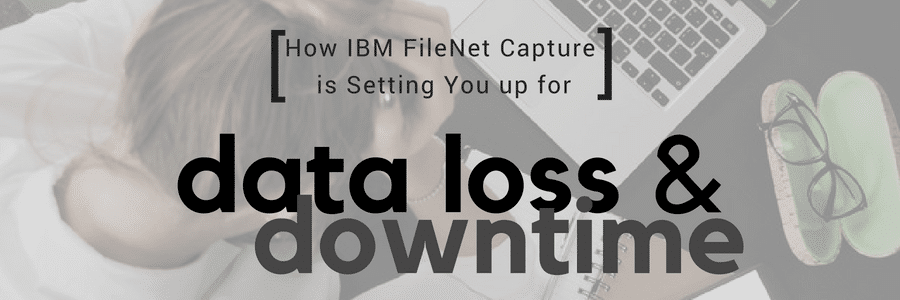By , Senior Systems Engineer
If your organization currently uses IBM FileNet Capture, your operations are at risk.
IBM recently announced that they will discontinue support for IBM FileNet Capture on September 30, 2019.
What This Means to Organizations With FileNet Capture
You’re Losing Support
Usually, IBM will at least continue to offer extended support to customers after the end of life date, but for FileNet Capture this is not the case. This means if you continue to use the system and run into problems, you are completely risking your company’s data if there are any issues with the software or system.
Downtime is Likely
Here are a few stats for you to chew on.
- 43%
- 51%
Forty-three percent of companies that suffer catastrophic data loss never reopen. Fifty-one percent close within two years.
Average cost in dollars of downtime per hour.
– Why Disaster Recovery in the Cloud Should Be in Your Plans, International Data Group, 2015
%
Downtime incidents caused by human error alone. Natural disaster accounts for only 10% of downtime.
– Enterprise and the Cost of Downtime, Independent Oracle User Group
I think you get the picture that data loss and downtime are a big deal.
If your system is suddenly unable to capture loan applications or claims or financial statements (or worse yet – experiences glitches and captures data incorrectly), your processes will quickly slip into disarray.
Employees will become drastically inefficient if they have to manually enter data into the system which will be a costly repercussion. This is compounded by the fact that most people these days, especially millennials, expect fast turnaround times and customer service. Your customer relationships are on the line as any downtime could be disastrous.
Solution: Port to a New Capture System
Since FileNet Capture is an IBM tool, the most logical capture system to port to is IBM’s Datacap product. Datacap is a similar product, but with far more advanced capabilities such as cognitive processing, the ability to export information to a range of applications and repositories (rather than just IBM FileNet Enterprise Content Manager and FileNet P8), adaptable rules-based capture and more.
Here’s a basic list of the differences:
- Scan, index, image-enhance, perform data recognition, route and commit content to all IBM FileNet repositories
Fax, batch export and import
- Fax integration and batch file import of any digital object from a file system
- Proven document security
- Increases enterprise productivity
- Lowers system costs
- Enables management of valuable business information
Global language and OCR support
- All data structures are converted to Unicode
- OCR language support
Desktop and Professional applications
- Capture Desktop – for departmental and workgroup scanning applications
- Capture Professional – capture,s manages and distributes content for enterprise-wide business applications
- Supports scanners, fax, digital files (PDF) and images from applications and mobile devices
Cognitive processing
- Uses machine learning to automate the processing of complex or unknown formats and highly variable documents
Export to other targets
- Export documents and information to a range of applications and content repositories from IBM and other vendors
Adaptable rules-based capture
- Configurable capture workflows and applications
Role-based redaction
- Redact documents automatically based on the role of the requester
Role-based job filtering
- Automatically divides content ingestion workflow using role-based job filtering
Unfortunately, there are no tools to convert from one product to another, so organizations should investigate premier solution providers that have extensive experience in both IBM FileNet Capture and IBM Datacap to ensure the transition is performed as seamlessly as possible.
When choosing a partner, these are some things to look for:
- Extensive experience in document capture with different products
- Ability to develop complex solutions for various clients
- IBM FileNet Content Manager experience (because at the end of the day that’s where the documents will end up)
How to Port to IBM Datacap
If porting to IBM Datacap is the route you take, this is the process that I recommend you follow:
- Analyze your current capture system. The partner you choose should spend ample time understanding your current capture system and your business requirements. They should leave the analysis phase with an understanding of…
- The kinds of documents that enter your system
- The information and data extracted from the documents
- Sources of content (email, mail room, etc.)
- Your current setting collections, templates and capture paths
- Port/Redesign the capture system in Datacap. A good partner will map your processes, requirements, etc. similar to what you previously had so that changes are minimized and not too jarring for end users.
A huge benefit to this whole process is the new capabilities you’ll receive with Datacap. Moving from FileNet Capture to Datacap is not a one-to-one move — it’s an upgrade.
Here are some functionalities you’ll receive with Datacap that FileNet Capture doesn’t offer:
-
- Client-server architecture that allows for scalability
- Capture emailed documents
- Automatically capture metadata from documents using advanced extraction techniques (optical character recognition, intelligent character recognition, optical mark readers, barcodes, keywords, etc.)
- Enhanced/unlimited data validations of fields such as database and web service lookups, math calculations, etc.
- Confidence ratings on each recognized character will be used to display document and fields to an operator if under a configured minimum level
- Allowing batches and/or documents to skip the manual indexing step if all fields are automatically populated and validated
- Process documents using a web interface (TMWeb if using IIS or Datacap Navigator if using IBM Content Navigator)
- Leverage Click and Key which populates index values by clicking on them and not requiring users to type them (as shown in video below)
- Export documents and metadata to many different locations and repositories such as file systems, databases, Documentum, IBM FileNet P8, IBM Content Manager and CMIS compatible repositories
Even though IBM FileNet Capture end of life may seem a little scary, upgrading to a new capture system like IBM Datacap will protect your data and provide you with significant new capture capabilities.
Do you have FileNet Capture? Fill out the form to let us know and we can talk about next steps.

Dave Prizlow
Senior Systems Engineer
About the Author: My favorite thing about working at Pyramid Solutions is the everyday challenge to find ways to improve our client’s business processes using technology. Outside of work, I like to follow the financial markets, play various sports – especially basketball and golf, get together with friends to play games, and relax at our cottage in northern Michigan.


